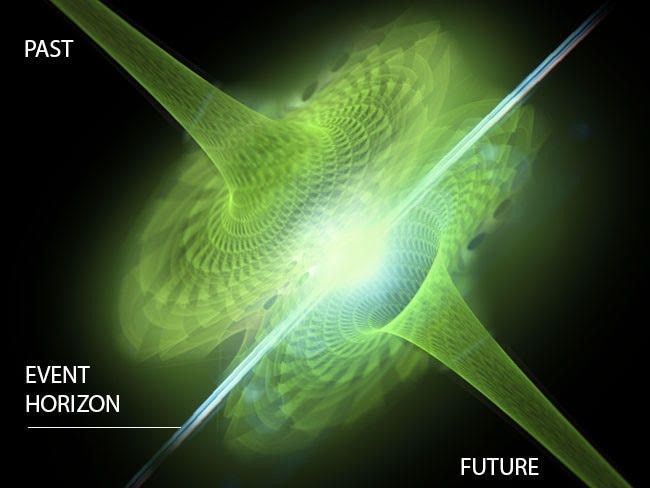DOES the intense gravity of black holes twist time and space so much that the future gets turned on its head? Some mind-bending new ideas by US astrophysicists suggest so.
THINK of a holographic picture.
It’s a flat, two-dimensional film. But it contains all the information our eyes need to perceive a three-dimensional projection.
That’s how scientists think of black holes.
The event horizon is a region where the dimensions in which we live — up and down, around — get squashed and time itself is stretched.
It’s one of the aspects of black holes where the mathematic principles which govern our universe appear to go wrong.
The confounding concept of infinity just keeps rearing its ugly head and breaking all the equations.
It’s a similar problem with time.
We would perceive a spaceship approaching a black hole as eternally slowing down. But what happens once it passes through the event horizon?
“The event horizon is a region where all of the three-dimensional information about the black hole can be contained on a two-dimensional surface — just like a hologram,” says Dr Luke Davies of the International Centre for Radio Astronomy Research in WA.
What if it is a holographic photo with two sides?
A recent study in the Journal Physical Review Letters has unusual implications for the whole time bit.
Would the spaceship come out the other end, slowly speeding up — backwards?

FORCED PERSPECTIVE
Given the way physicists define the formation of a black hole, event horizons must ‘be aware’ of the entire history of our universe. From Big Bang to Big Crunch / Big Chill / Big Rip (we’re uncertain how it will all end). All of it must be etched on that weird point where light can no longer travel along its merry way.
Black holes are stars which have collapsed under their own gravity. A paradox kicks in at this point, throwing our understanding of universal laws into confusion. The event horizon — the point at which light falls into the black hole — cannot “know” anything about what’s deeper inside because light cannot escape.
But the location of the event horizon is defined by the matter which is inside it.
“As such, the event horizon must “know” how much matter will ever cross it in the entirety of the Universe, to know how big to be,” Davies says. “This is called the teleological paradox. It’s unlikely to work that way, but is just a consequence of the idealised way we view black hole formation.”

THE MATTER OF TIME
The idea of a 2D hologram puts all the math and theoretical constructs into a new perspective by defining black holes in a slightly different way. It’s a perspective which ‘fits’ what we know about space and time.
It’s a perspective which twists entropy — that immutable force in the universe which sees everything gradually tumble into a state of chaos. Many physicists believe entropy must be part of what causes our perception of time. It’s called thermodynamic time.
So what happens to time at the event horizon?

At a black hole’s event horizon, entropy — from its most active and orderly state at the Big Bang all the way down to the fuzzy chaos of the end of time — reaches a boundary.
It’s caught between two regions of very strong gravity, producing a two-sided 2D hologram.
The idea is that it’s all there — forming a projection that reaches back into the past and forward into the future.
This idea shows how the event horizon could “know” everything there is to know about the past and future — and act accordingly.
On one side of this hologram, entropy and time are expanding. Going forward. This is time as we know it.
On the other, they are contracting. Going backwards. Entropy and time are reversed.
“An interesting consequence of this would be that if the Universe stopped expanding and began to contract towards a big crunch,” says Dr Davies. “It implies that time would slow down as the universe got smaller and smaller — until it collapsed into its own ‘universal event horizon’.”
This would be the holographic opposite of the Big Bang.
“At that point in time the universe would reverse,” he says.

KEEPING THINGS RELATIVE
It’s a neat, compact concept which could help solve some of the mind-bending paradoxes black holes present to the mind of physicists.
In particular, it fits neatly with Einstein’s seminal Law of Relativity.
Black holes have long been a thorn in this idea’s side.
Relativity states we live in a four-dimensional Universe where space and time are relative to your movement through these dimensions, while the force of gravity curves and warps both space and time in strange ways. It’s a theory that has been repeatedly demonstrated in the universe as we know it.
But apply it to black holes … and the idea falls apart.
Until now. Possibly.
The concept of a two-directional entropy hologram being part of an event horizon appears to preserve Relativity’s role at the centre of our understanding of physics.
But, like all physics, it needs to be put to the test. Repeatedly.
Time will tell.


Add your comment to this story
To join the conversation, please log in. Don't have an account? Register
Join the conversation, you are commenting as Logout
Here’s what you can expect with tomorrow’s Parramatta weather
As we move into summer what can locals expect tomorrow? We have the latest word from the Weather Bureau.
Here’s what you can expect with tomorrow’s Parramatta weather
As spring moves into summer what can locals expect tomorrow? We have the latest word from the Weather Bureau.